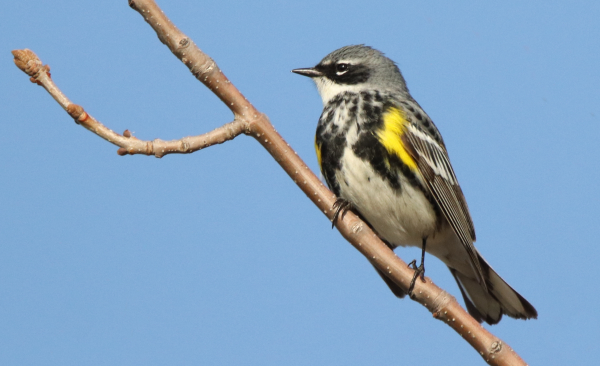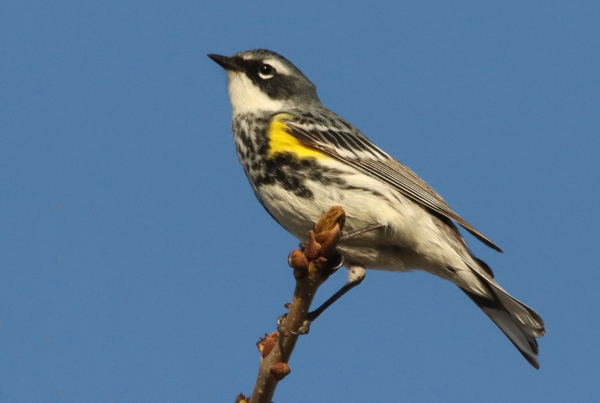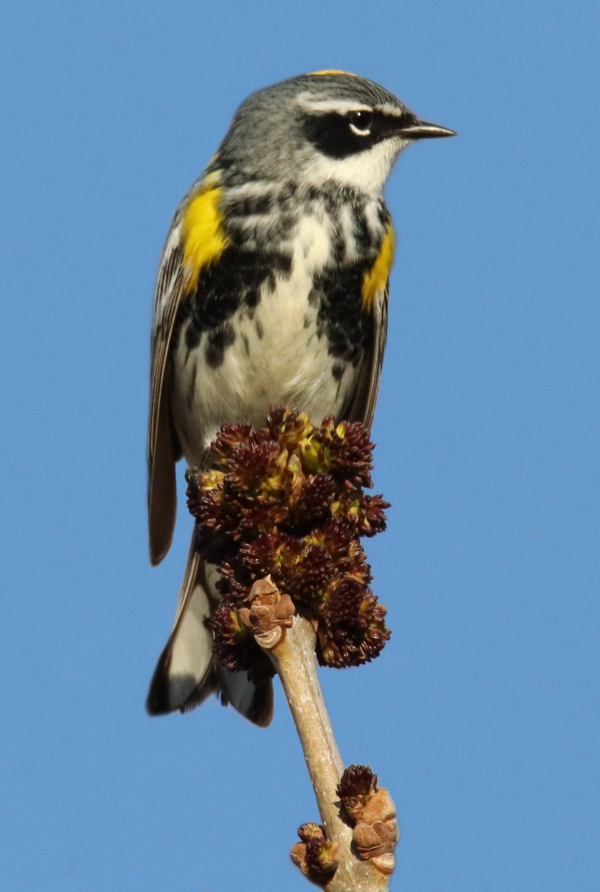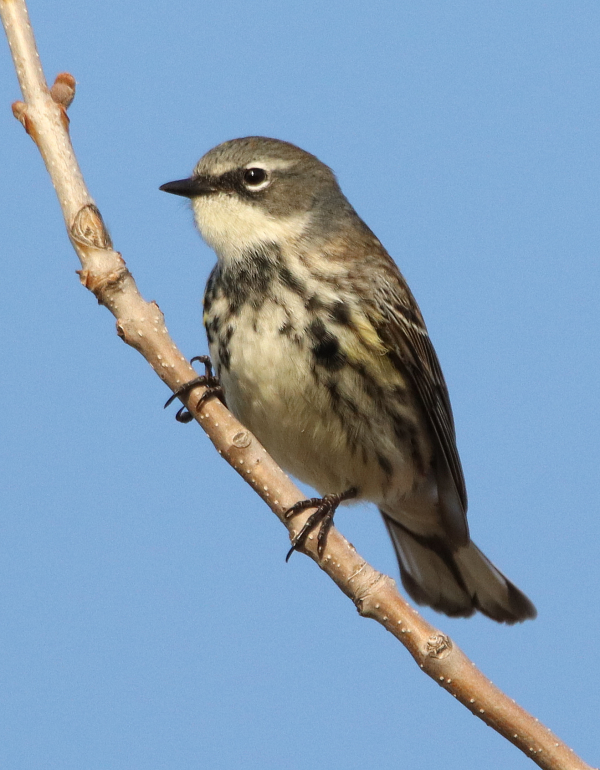The sky was gray as the first warblers of spring revealed themselves last Wednesday outside my bay windows: First a Yellow-rumped Warbler, followed by an Orange-crowned Warbler, then more of these first warblers to grace the treetops and eventually the elm tree adjacent to my feeding station – an Orange-crowned Warbler perched right outside my windows, just a few feet away. With sunshine the following morning, I checked my nearby warbler fallout hideaway – Melody’s Grove – to take the first warbler photos of the season. For about an hour I enjoyed a continuing parade of Yellow-rumps along with a few Orange-crowned Warblers and the first Black-and-white Warbler.

An interest in trying to eliminate a distracting background eventually worked well during the first warbler photo sessions of spring. Almost all of the first warblers to arrive were adult males, all belonging to the Myrtle race of Yellow-rumped Warblers (600mm zoom lens, f-6 aperture, 1/2000 shutter speed, 800 ISO).
Photographing warblers at Melody’s Grove has become an annual thrill during May, and because it’s located only a couple hundred yards from home, it’s always my first stop to check on migrating songbirds, flycatchers, and other birds each morning and late afternoon. After Melody’s I checked my 2 other warbler fallout sites between 10 and 15 miles to the south-southeast. Just one Yellow-rump showed in the trees on the east side of White Lake, along with a Brown Thrasher, so I wasn’t expecting much at the Country Schoolhouse Grove. I was happily wrong though, as there was an abundance of warblers – all Yellow-rumps with a single Orange-crowned Warbler, plus an even smaller Ruby-crowned Kinglet. The sun was low, so even when the warblers were perched on high branches, there was only a slight shadow beneath them, on their breast or belly – a big plus when photographing any birds.
The New Warbler Photo Plan
One of my new efforts to get better warbler photos this May is: When I find a number of warblers feeding in an area, I am positioning myself or my mobile blind where there are bare branches with a blue sky background behind them. When this plan works, a warbler perches on one of the bare branches as it forages from location to location, giving me a clear-view background for the bird to stand out against the sky. So often when we photograph warblers, there tends to be a distracting background filled with sticks and leaves and such, so this technique is proving to work fairly well. It could actually be considered something of a portrait setup, but with an abundance of similar sticks, branches, and other open perches I can be mobile while keeping aware of the best open perches at each stop I make along the edges of a tree grove.

By concentrating on warblers that perched on open branches at the perimeter of trees, “the new warbler photo plan” was designed to eliminate a distracting background of twigs, leaves, and branches that is often hard to avoid (600mm zoom lens, f-7 aperture, 1/1600 shutter speed, 800 ISO).
There are an abundance of bare branches now, including branches that haven’t had leaves or flowers burse out of them yet. The open perch plan also includes branches on the sides and tops of trees, but its best to try to photograph where potential perches are as close to eye level as possible. I try not to photograph the undersides of the birds, which is a common practice when warblers are feeding in the treetops. As it stands, the first evening of warbler photography, last Thursday, I had pretty good luck with that effort – after the first hour.

Warblers are remarkably small, active birds that tend to forage among the cover of leaves and other vegetation, which makes them difficult to photograph. But the varied colors and unique markings of the 56 species that nest in the United States and Canada makes them especially attractive photo subjects (600mm zoom lens, f-10 aperture, 1/1600 shutter speed, 800 ISO).
|
The first hour the birds didn’t perch on the branches I hoped they would, although they perched on every other branch it seemed, usually out of sight. I positioned my mobile blind (car) at a familiar boxelder tree in bloom, but while warblers foraged in the relatively low old tree, only one perched in the open for a couple seconds. In the meantime, during that first hour I noticed the actions of 2 adult male Yellow-rumped Warblers that were foraging in a nearby tree, but it would require me to expose myself beyond my mobile blind, which turned out to work just fine. I’m always wary of leaving my blind, but I soon realized I was being far too concerned about how the birds would react to my advance and position. They noticed, but rarely did any react; they were constantly on the move, regardless of where I positioned myself. The 2 warblers I mentioned actually continued to forage in the same flowering boxelder tree until the low sun was consumed by a cloud bank – they continued, but I called it quits. What fun that photo session was, and the best photos I managed made it all the more rewarding!
Standing in the open for an extended period holding my relatively heavy lens affixed to my camera provided the first case of “warbler neck,” a common ailment among birders who are looking among the treetops at foraging warblers and other songbirds for extended periods. The photo equipment also provided a bit of shoulder fatigue, but the second evening of warbler photography didn’t result in the same initial petty ailments.
Photo Day 2
Melody’s Grove was pretty quiet Friday morning, with just a single Yellow-rumped Warbler showing during a brief visit I made, so knowing late afternoon sunlight was best for photographing at the Schoolhouse Grove, I returned hoping for another evening of warbler photo action. Thrilled to see Yellow-rumped Warblers throughout the grove, this time the interior of the grove didn’t offer the same photo action. The birds were there, but they weren’t predictable as far as where they were foraging, and they avoided the tree branches I parked near. After about 20 minutes I checked the north side of the grove, and there was an assortment of Yellow-rumps foraging on the wing, moving through the tree tops into the sunlight.

While most of the Yellow-rumped Warblers that arrived in the first wave of migrants where adult males, younger males and females soon followed. This image shows more of a shadow on the lower right side of the bird than is preferred, which suggests this warbler was positioned to the left of the optimum direction of the sunlight (600mm zoom lens, f-7 aperture, 1/1250 shutter speed, 800 ISO).
|
That prompted me to walk along the edge of the trees until I found a location where a couple bare branches reached northward into the blue sky. I slipped into a spot that I hoped was a good position and waited for warblers to perch there before and after they hawked insects out of the cooling air. There were a lot of Yellow-rumped Warblers foraging, but almost all were in the treetops, which didn’t present a good photo angle.
I continued to hope for a wayward warbler to perch on one of my preferred perches, and suddenly, one did! I quickly focused on the warbler and to my delight it paused a few seconds to look this way and that in perfect sunlight with a clear blue sky background – wonderful! I checked the photos on my camera’s LCD screen and they were just what I was hoping for. But the rest of the warblers remained high, even in branches directly overhead. It was probably time to reposition again.
Just then I heard a vehicle approaching on the nearby rarely used road. It was my friend Herb, a local rancher, so I walked back to my car where Herbie parked and we began visiting. “What are you photographing,” he asked as I pointed to the many warblers in the closest trees, just a few feet away. I shared some info about the birds, and Herb said it looked like they were following me as I walked up. “They were,” I answered jokingly. But it was suddenly evident that we were standing and talking before a large group of actively feeding warblers that were probably working their way along the edge of the trees to this northwest corner of the grove where we were standing.
There were 10 Yellow-rumped Warblers before us, and as I handed Herb my binoculars to get an even closer look I took advantage of photographing the warblers that were perching in the open where the trees were not as tall. There was a lot of action in the perimeter trees, with occasional warblers making a circular flight just above us or sweeping lower within a couple feet to catch one of the small flying insects that were hatching the past couple days – midges I believe. It was really my best opportunity to photograph the little birds, and it will be a memorable birding episode that I think Herbie will remember and appreciate as something of an initiation into a warbler migration stop.

The “new warbler photo plan” proved to be fruitful at one photo location, but as leaves are growing and vegetation becomes thicker, a second photo plan may be required. When photographing songbirds among vegetation, using an aperture of f-5 or f-6 to narrow the area in focus can be helpful to blur the background (600mm zoom lens, f-6 aperture, 1/3000 shutter speed, 800 ISO).
Although the Yellow-rumps are the most common warblers to make migration stops in this area, I only had a few quality photos of the species, mostly provided by a lone male I encountered nearby last spring. I was genuinely thrilled to get a number of fairly close, unobstructed photos with clear blue sky backgrounds. I also appreciated that this was great practice that would be valuable when other species of warblers and songbirds arrive throughout the days of May.
It was practice, but it was an especially exciting way to start the spring warbler parade at Melody’s Grove and the Country Schoolhouse Grove. In the meantime, I hope you have a chance to experience a warbler fallout, or at least a variety of individual warblers. Their vibrant spring colors and furiously paced activity levels really get me tuned into every sound and movement in the wooded groves, and that level of awareness, anticipation, and excitement extends to everywhere I roam in search of birds to photograph. What a thrill the first warbler photo sessions were, as they inaugurate another spring warbler migration!
Article and Photographs by Paul Konrad
Share your bird photos and birding experiences at editorstbw2@gmail.com